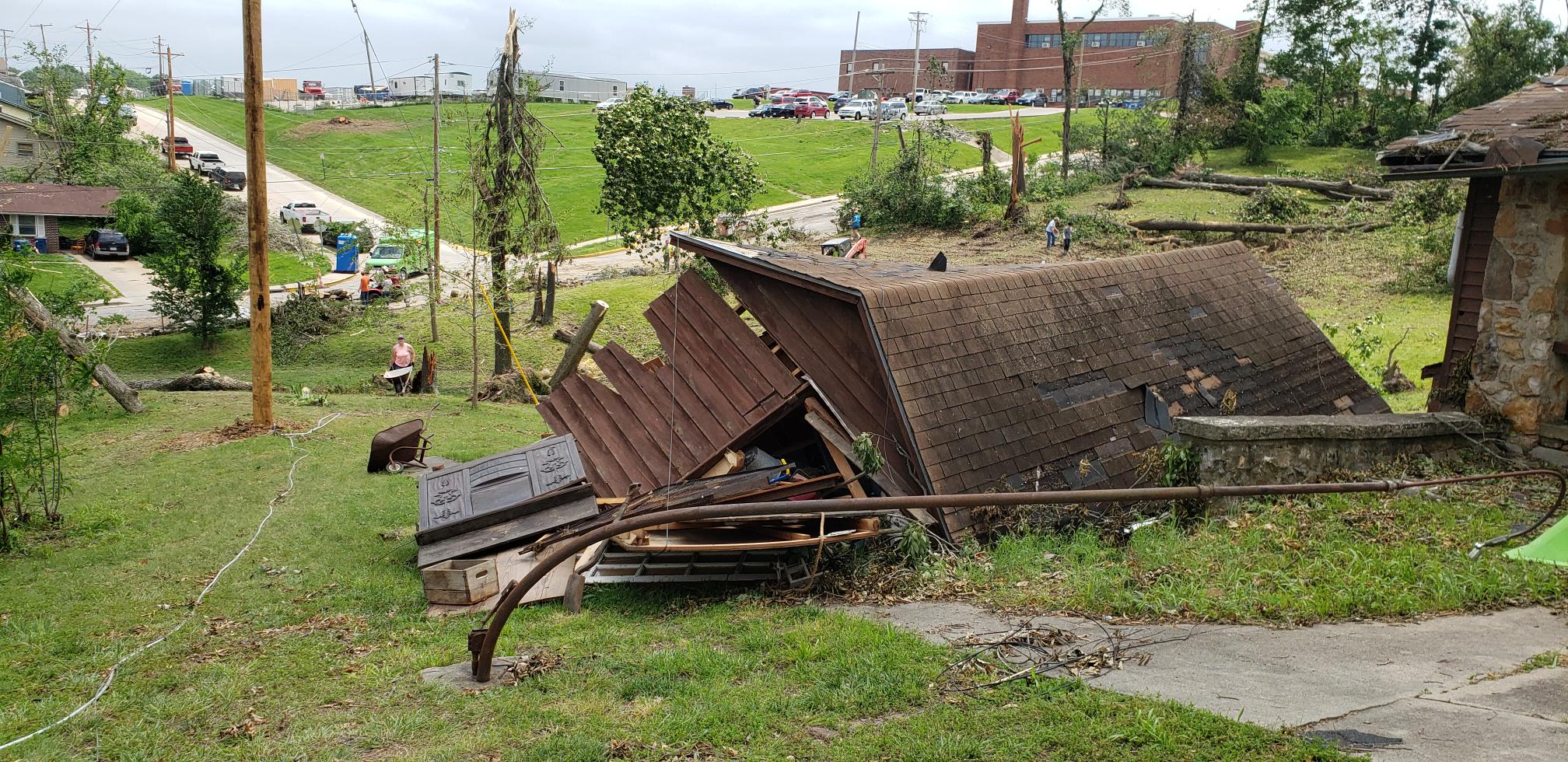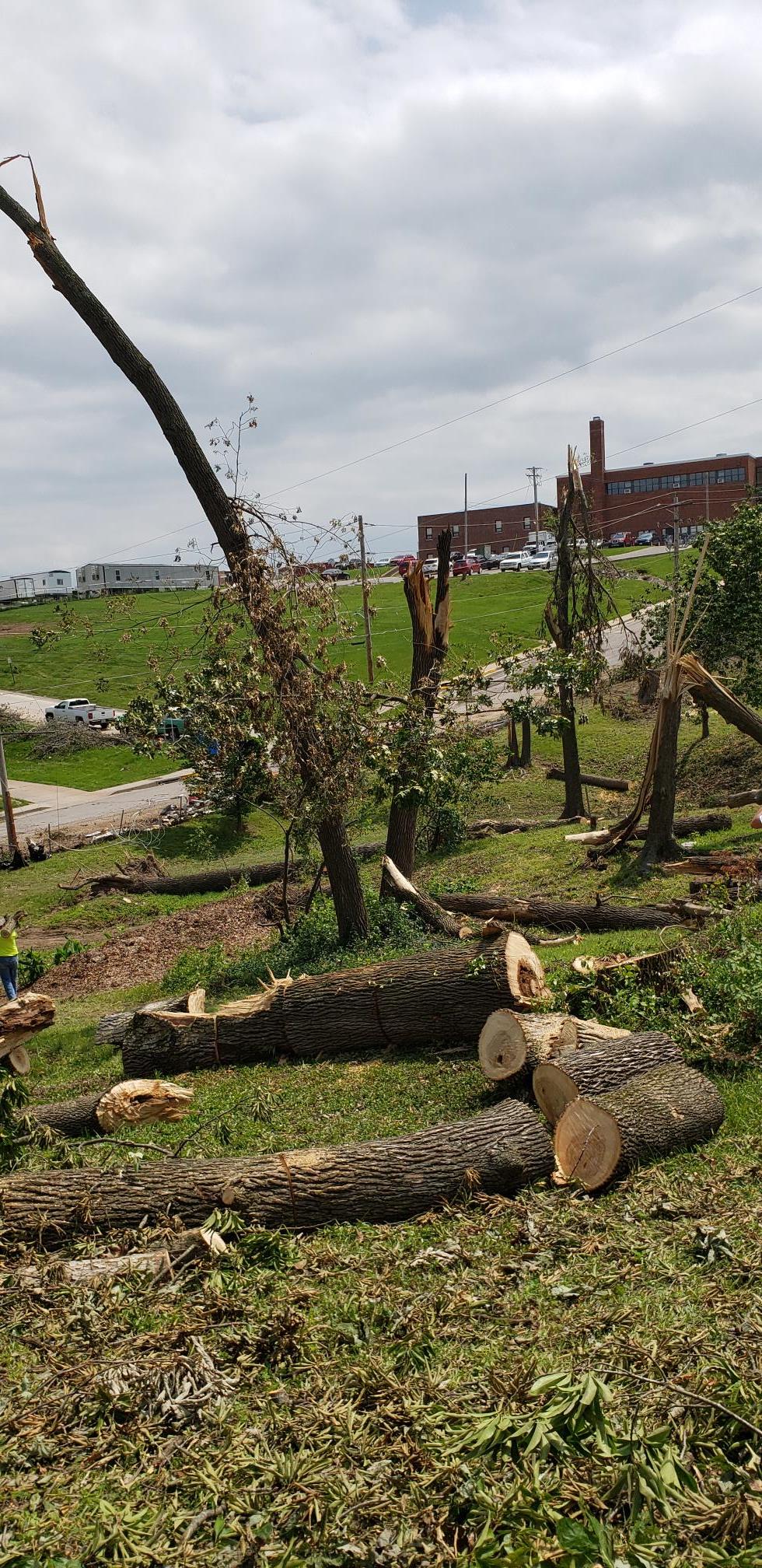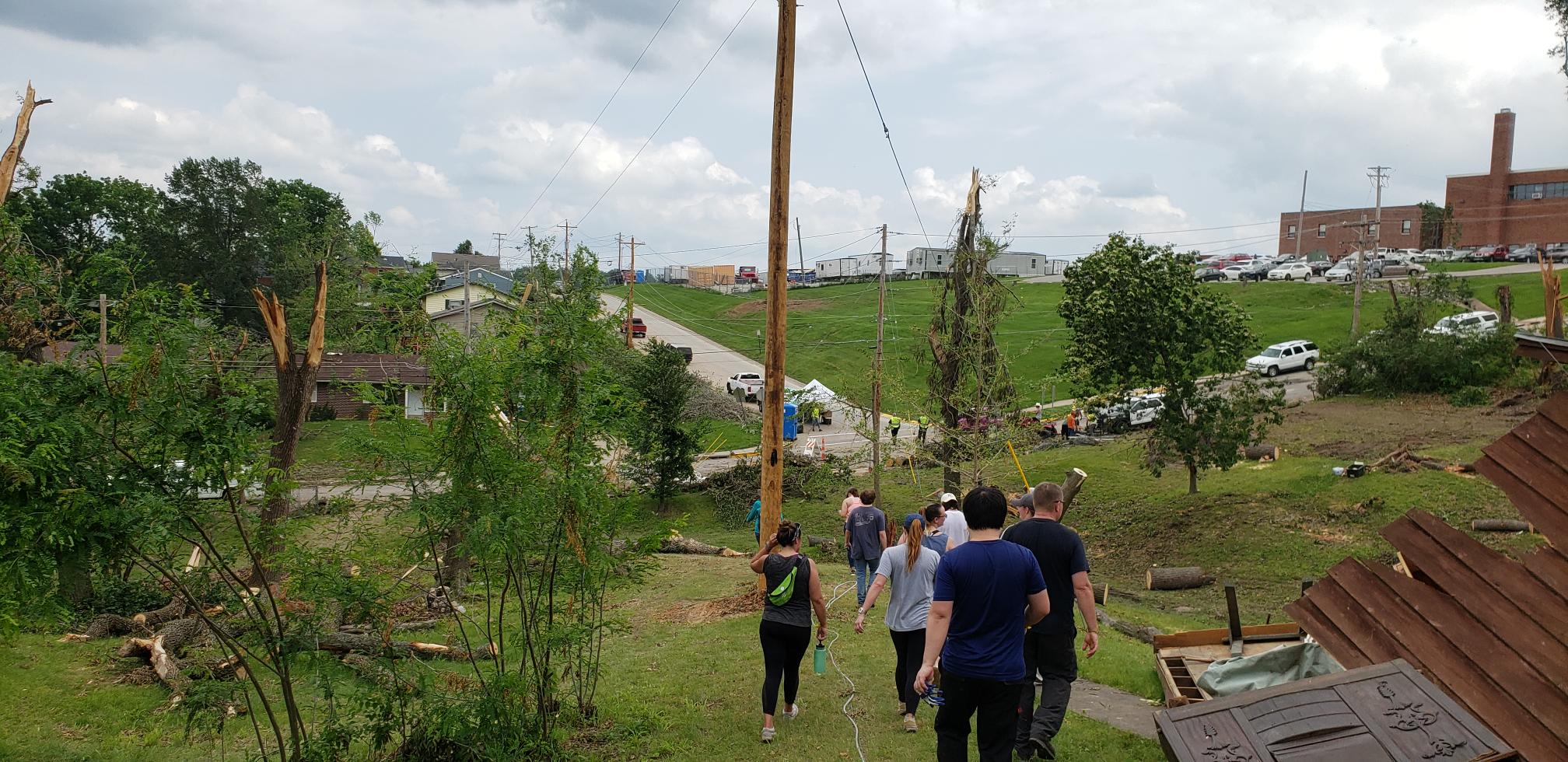Published on Aug. 26, 2019
Updated on Aug. 27, 2019

August 27, 2019
Near midnight on May 22, a tornado struck Missouri’s capital, Jefferson City. The storm damaged over 600 buildings and left many residents without basic utilities. This natural disaster was just one of the many from last spring that impacted Missouri communities. And the University of Missouri, in partnership with MU Extension, MU Health Care and local and state officials, was there to help — from cleaning up the damage to providing housing for displaced residents.
On this week’s episode of Inside Mizzou, Chancellor Cartwright talks with two members of the Mizzou community who assisted the Jefferson City tornado recovery efforts: Lynda Zimmerman, program director and engagement specialist in nutrition and health education for MU Extension in Cole County; and Marigrace Heinze, a junior majoring in biological sciences. They discuss how the university community came together to help those in need, as well as the complex road to full recovery.
Transcript
Moderator: [00:00:09] From the classroom to the cornfield, journalism to SEC athletics, the University of Missouri works 52 weeks a year, every year. This is Inside Mizzou – real stories, real discoveries and real impact of the Mizzou community. Today’s episode is called “Cole County Clean Up.” Near midnight on May 22nd, a tornado tore through the heart of Jefferson City, the capital of Missouri. It destroyed blocks of businesses and left many residents homeless. The next morning, the University of Missouri community and many from across the state sprang into action. Today, Chancellor Cartwright is joined by two individuals who played a unique role in the recovery efforts: Lynda Zimmerman, program director for MU Extension in Cole County and an engagement specialist in nutrition and health education. And Marigrace Heinze, a junior majoring in biological sciences with minors in history and psychology, who traveled with a group of Mizzou students the day after the tornado hit to assist with the efforts. Thank you all for being here.
Everyone: [00:01:09] Great to be here.
Moderator: [00:01:11] So, I want to start with you, Lynda. You work in Jefferson City. You’re a part of the community there. Can you describe the night of the storm and its immediate aftermath?
Lynda Zimmerman: [00:01:20] Well, the night of the storm, I remember it vividly because living in Columbia, we had tornado warning after warning, sirens were going off and then right around probably a quarter to midnight we were all clear. So I went to bed, and it wasn’t until the next morning I woke up and I heard immediately the news on my clock radio. So that was for me not knowing — I went to bed thinking, Oh, everything’s fine. And then I woke up to find that the destruction had happened.

Moderator: [00:01:54] Right. Right. So what did the first days after the tornado look like for the Cole County Extension? How did you guys get started with the recovery when there was so much to do?

Lynda Zimmerman: [00:02:03] The first day after the tornado, I think everyone was pretty much in shock just because you never imagine it’s going to happen in your community. And just getting to the office that day, I remember, I knew that Ellis Boulevard was like completely demolished because those were all of the images that were going all over the news broadcast. And so I knew I had to take a different route to get to the office. And once when I finally got there, we had no internet and no phones. We were fortunate to have power, but it was just the unknown when I was driving there, because, of course, I’d seen the images. Our office is very close to where the destruction hit – the path on Ellis. We’re probably at maybe a half a mile down the hill from that. And so just not knowing what to expect. But we were very fortunate. We just lost one tree limb. That was it. And so then the second thoughts were going to, actually, my first thoughts were to the staff that live in Jeff City and just making sure that they were OK. And once I found out they were OK, then wondering what the office was like. And when I found out that was fine, then it really started setting in, like, “OK, what do I do now?” I mean, we’ve had training. As a county engagement specialist, I am part of the region-wide emergency management team. So we’ve had training. But until it hits you, you really don’t know like what do I do? And so the first thing I did do is I reached out to my colleagues, some that had gone through tornadoes in other parts of the state. And just to get some advice from them, like, “OK, what should my first steps be? Because there are so many needs. And I’m just not knowing exactly where, where do I best fit in?” So I reached out to all of my colleagues. And the strength of MU Extension is that we have specialists who work in a broad range of discipline areas and each one of us then brings those resources that involve a different area that has to do with the tornado recovery.
Moderator: [00:04:28] No, I can only imagine. And so, Marigrace, you were there so soon after the tornado that entire sections of the city were closed off due to safety concerns. Amid that scene, is there any image or story that sticks with you? Also, what was your job as a volunteer?
Marigrace Heinze: [00:04:42] Yes. So the day we actually went to go volunteer, we were supposed to tour Missouri’s version, like the state version of FEMA’s headquarters. And obviously they were very busy. So instead we volunteered and we hopped on one of the white buses and headed down there. And I don’t go to Jefferson City very often, but I remember a bit about it and I remember sitting in the bus and I was like, “Wow, I don’t remember the river being so close to the highway.” And then we kept driving and then I saw an irrigation system sitting on the water. And then I saw buildings in the water. And it really hit me like, “Oh, this is a lot of flooding.” Like there’s more, too, you know, and we had all those torrential rains and everything. But it just hit me a lot that Jeff was really going through a lot, you know, with all of it. And so we ended up meeting at the mall there. And that was like their volunteer headquarters where they were designating groups to go in. The organization stated that they were still in Phase 1 of cleanup, which is focused on plant and tree debris, really. So that they could get roads clear and get more access to houses and then they would start structural damage control and cleanup. So we were assigned the home of an elderly woman who — it was hard because when we went to this neighborhood, you could tell it was like a really beautiful old neighborhood. But there were windows boarded up for when they had shattered and there were like parts of roofs missing. And I remember just seeing that I was just like: Wow, like I hope number one like they have somewhere to go. Like, number two, I hope they have some form of insurance. You know what I mean? Because I know I wouldn’t be able to pay for that kind of repair. You know, so suddenly. And then just walking through, we had to walk through the neighborhood and we saw, you know, just all kinds of building tiles and all kinds of stuff all over the ground. But we got to the woman’s house and she had this beautiful big old Victorian kind of style house. And you could tell she lived on like two acres and a hill, and you could tell she probably had a handful of like 80-foot trees before and everything, but it had turned to field. So there were tons of volunteers and people from the actual organization had chainsaws and axes to cut off everything. And our jobs were to either carry the wood up the hill or down the hill to the street so that it could be removed by the cleanup crew. It was really humbling to see all the damage and everything because I also live in Columbia. And, you know, like my house was fine and like my day-to-day life was OK, you know? So it was really an honor to be able to go and volunteer and help and be part of the recovery process for everything.
Moderator: [00:07:56] Right. OK. And so the group that you went with wasn’t the typical volunteer group, I’ve heard. So can you tell us more about the group you went to Jefferson City with?
Marigrace Heinze: [00:08:05] Yes. So it was a Maymester class taught by Jerritt Frank of the History Department. And the class is titled “Acts of God.” And it is about natural disasters and how as a society we analyze them and what leads up to natural disasters and how we react to them. And so that class we were able to go on a lot of tours, which was really exciting. We went to the water treatment plant here. We went to Mizzou’s power plant. We went to the Callaway Nuclear Power Plant, which was really great. Mark Twain National Forest to learn about forest fires. And we were also lucky enough to go to the U.S. Army Corps of Engineers Locks and Dam Way out in Alton, Illinois, which was really great. So yeah, it’s a wonderful class. Dr. Frank is very passionate. And if anyone needs a summer humanities, I think it’s a great class to take.

Moderator: [00:09:04] OK, so definitely one you would recommend?
Marigrace Heinze: [00:09:04] Absolutely.
Moderator: [00:09:07] OK. So, Chancellor Cartwright, it’s been a difficult year for severe weather in Missouri. What’s the role of MU when large-scale disaster strikes the state?
Chancellor Cartwright: [00:09:15] You know, we’re a large institution. So when you think about Mizzou, we are, of course, here in Columbia, but we have extension sites across the entire state. 114 counties. And we are not just part of this community, but we’re part of communities throughout the whole state. We have staff, students, faculty that are from all of the areas across the state. And so we see the entire state as our community. Remember that I keep talking about the fact that we’re not just the University of Missouri, but we’re the University FOR Missouri, and we’re here to help. And we’re fortunate enough that we have, of course, people like Lynda and Marigrace who want to participate and help with these activities. But we have formalized structures for that, too. Our Extension office actually has a community emergency management program that puts a formal structure around responses to emergencies. They’ve been heavily involved in the flooding. Marigrace mentioned the flooding and going down into Jefferson City and seeing that. And we, of course, talked about the tornado. But the flooding is also all across Missouri, too. And people are having to deal with that. And so we have mechanisms where we can get experts, people who have a lot of knowledge about what the best way to deal with some of these emergencies. And we can get them at the location of the emergency and help as much as possible. In addition to our students and our faculty and our staff volunteering to help in whatever way that they can. So we take it, you know, we take it as part of our obligation to the state and to our community to make sure that we continue to help.
Moderator: [00:11:02] Of course, you know, recovery is very important and it’s not just a chance to rebuild what was there, but also an opportunity for communities to come back even stronger. So how does MU Extension and even our broader Mizzou community facilitate community growth as well as recovery?
Chancellor Cartwright: [00:11:17] You know, the way that I like to think about what Extension does is really, it’s about empowering people, empowering people to help them help their own communities. That’s through education services. Lynda is an Extension specialist in nutrition and health and works with people around nutrition and health. You can probably explain it better than I can, Lynda. You know, eating, everything about diet and other things and how you can continue to be healthier. And this is really important to a community. And so we have people throughout the state that work with their communities around those issues. But also, we have them working directly with our research farms, for example, and at our research farms they’re looking at what’s the best way to rotate crops, what’s the best way to work with our animals. And that information is wonderful. That research is wonderful, but it isn’t as useful as it can be if we don’t actually get it into the hands of the people that need it. And so it’s about empowering all of the residents of this great state and allowing them to use that information to advance economically and also to advance their education and advance their health so that we look at it as a holistic program. And we have a terrific leader there, Marshall Stewart, who has really been working very closely with people from the state government, from the federal government, and thinking about how we can do the best to help the state.

Moderator: [00:12:55] Of course, as you know, Chancellor Cartwright, you mentioned a lot of things. You know, rebuilding is a long process. And so, Lynda, what still needs to be done and how does Extension play a role in that recovery?
Lynda Zimmerman: [00:13:05] Yes, there is still so much yet to be done. The short-term response is doing very well there. Cole County is moving toward developing a longterm recovery committee. I will be a part of that. And so that committee looks at really taking, helping people with their longterm recovery and stabilization. Right now, in the short-term, we’re just like trying to find them a place to stay temporarily. But they need more than that. You know, they need for the longterm to get their lives back together. And so there’s a whole list of different functions that the long-term recovery committee addresses — everything from volunteer coordination, construction, the spiritual and emotional care of individuals, case management and also the financial aspects of receiving moneys from grant sources. There needs to be some structure there to receive those moneys. And so it’s really not a simple matter. You’d think, oh, we’ll just get a committee together and we’ll work on these issues. But it’s actually very complicated, and it does take time to do it right. There are some legalities to doing it the right way. So I am going to be a part of that. And where Extension doesn’t fit neatly into any of those areas that I mentioned, we overlap so much of it. And the strength, again, of Extension is that we’re there in the community and we can provide technical assistance. We can also help further the discussion of the different agencies and organizations to help people to cooperate and work together. Because as Bill Farr, the emergency management director, said, Cole County is just blessed with having so many great resources. We have all kinds of agencies and volunteer organizations. But if we don’t work together, it’s not going to go very far. So we have to be unified in that effort, and that’s where Extension really can help with that. And also, I see my role as listening and finding out what the needs are and where the University of Missouri, then — different resources can be tapped. Because there’s so much that the university offers — whether it’s that some kind of expertise in a certain area that’s just sitting here, someone on the campus that I can tap into that and then bring that resource to Jefferson City where it’s needed.
Moderator: [00:15:55] Of course. Wow, that’s awesome. Thank you all for being with us today. Now, there’s just one more thing to do before we leave. How does NASA organize a party?
Lynda Zimmerman: [00:16:08] I don’t know.
Moderator: [00:16:10] They plan it!
Everyone: [00:16:10] (Laughing)
Chancellor Cartwright: [00:16:10] Ha, very good.
Moderator: [00:16:16] Our audio engineer is Aaron Hay. Our featured music is composed by MU master’s student Niko D. Schroeder and performed by the Donald Sinta Quartet. You can find more information about Niko, the Quartet and their piece on the Inside Mizzou webpage. Make sure to join us next time to stay on top of what’s happening at Mizzou. Thanks for joining us on this episode. See you around the Columns!
